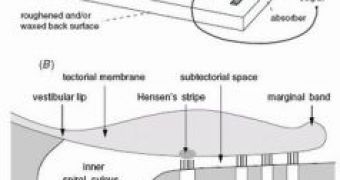An artificial cochlea would be the solution for millions of deaf people around the world.
But researchers know not so much about how the living chamber works.
Recently, researcher Andrew Bell said the cochlea presents similar structure and electromechanical properties to a common surface acoustic wave (SAW) resonator.
The cochlea is a spiral-shaped, hollow bone in the inner ear, harboring the inner ear, having a vital role in sensing, processing, and amplifying sounds.
Bell uses the discovery in 1978 that most human ears in passive behavior continuously emit very pure, soft tones-sounds which can be picked up with a sensitive microphone.
The theory of a hydrodynamic stimulation of hair cells (stereocilia) does not encase the fine tuning, so Bell imagined that the outer hair cells in the cochlea actively amplify sound.
"When you listen to a recording of the sound that the cochlea makes, you hear something like a carillon of wind chimes," said Bell. "It's easy to get the impression that something seems to be resonating."
He developed a model with a cochlea functioning like a SAW resonator, commonly used in cell phones due to its small size.
SAW resonators create electromechanical waves between them whose wavelengths correspond to the spacing of the electrodes.
Bell observed the resemblance of the outer hair cells with the electrodes on a SAW resonator: they always lie in three well-defined rows.
The waves align with the rows of hair cells, with the first and third rows placed in antiphase with the second row.
Like a SAW resonator, the cochlear amplifier would work in a feedback circuit mediated by the waves.
As the hair cells are planted to soft tissue such as the gelatinous tectorial membrane, feedback in the cochlea needs a slow-moving wave, with a very short wavelength.
Bell imagined that using "squirting waves" that arise in fluids constrained in ways similar to those found in the cochlea, and the SAW configuration, the cochlea could theoretically provide sharp resonance frequencies typical of the human ear, in the range of 20 to 20,000 Hz.
"The idea is that cells are not lonely, independent entities unaware of other cells," said Bell.
"Instead, cells appear in populations and cooperatively interact so as to perform signal processing. We have long known that nerve cells process information via a network of interactions (neural nets), but here we see a preneural example: outer hair cells act both to detect sound and pass it on to neighboring cells, which do the same. Shuttling of signals back and forth leads to positive feedback and frequency analysis, and this might prompt us to look for similar interactions among other sensing cells. Visual, olfactory, and balance cells, for example, could well work in similar ways."
A cochlea based on the active processes residing in the resonator analogy would be the answer for overpassing the problems posed by previous models of artificial cochlea.
"A SAW-like cochlea would form a rugged spectral analyzer-a reasoning behind existing artificial cochleas-but it could be much more sensitive then existing prototypes," said Bell.
"Future research needs to be directed to validating the SAW resonator model," he said.
"But then there are finer features which call for explanation, too. What is the purpose of the 'V' shape of the stereocilia, for example? There is reason to think it could relate to detecting musical ratios in sounds, and if so this would give a marvelous physical underpinning to our remarkable musical sense. The cochlea may be highly tuned-and musical."
Image credit: Andrew Bell.

 14 DAY TRIAL //
14 DAY TRIAL //